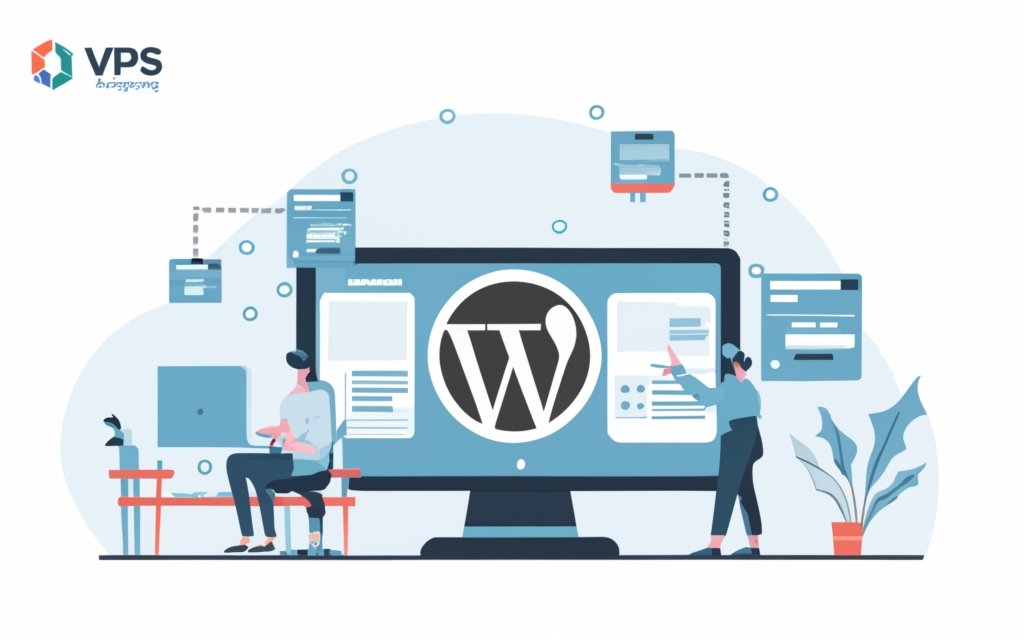The Role of VPS (Virtual Private Server) in WordPress Load Balancing is a crucial aspect of optimizing and managing a WordPress website efficiently. Load balancing refers to the distribution of incoming traffic across multiple servers to ensure optimal performance and prevent any single server from being overloaded.
Load balancing is of great importance for WordPress sites due to their increasing popularity and the potential for high website traffic. It helps distribute traffic evenly, improves website speed and response time, and ensures high availability and reliability.
But what exactly is VPS? A Virtual Private Server is a virtualized server environment that operates independently of other websites, providing users with dedicated resources and control over server settings. VPS not only offers scalability and flexibility but also ensures high performance and reliability for WordPress websites.
VPS plays a pivotal role in WordPress load balancing by providing the following benefits:
- Scalability and Flexibility: VPS allows you to easily scale up or down the server resources according to your website’s needs, ensuring optimal performance even during traffic spikes.
- High Performance and Reliability: With dedicated resources, VPS offers improved performance and reliability compared to shared hosting, resulting in faster loading times and a better user experience.
- Improved Website Speed and Response Time: Load balancing with VPS helps distribute the workload efficiently, reducing server response time and enhancing website speed.
To set up VPS for WordPress load balancing, there are specific steps to follow, including choosing the right VPS provider, configuring and optimizing server settings, and setting up load balancer software.
Besides, there are best practices you should consider, such as regular monitoring and maintenance of your VPS, implementing security measures for both VPS and load balancer, and conducting load testing and optimization to ensure optimal performance.
By leveraging the capabilities of VPS, WordPress websites can achieve efficient load balancing for improved performance, scalability, and reliability, ultimately enhancing the user experience.
Key takeaway:
- VPS maximizes WordPress load balancing: Using VPS allows for scalability, flexibility, and high performance, ensuring efficient load balancing for WordPress sites.
- Improved website speed and response time: VPS enhances the speed and response time of WordPress sites, resulting in better user experience and satisfaction.
- Best practices for WordPress load balancing: Regular monitoring, security measures, and load testing are essential for maintaining an optimized and balanced WordPress site using VPS.
The Role of VPS in WordPress Load Balancing

Photo Credits: Www.Uncleb.Tech by Kenneth Torres
The Role of VPS in WordPress Load Balancing
When it comes to WordPress load balancing, Virtual Private Servers (VPS) are crucial. Here are some key points to consider:
– VPS provides scalability: With a VPS setup, you can easily scale your WordPress website to handle increasing traffic. You can add more VPS instances as your website grows to efficiently distribute the workload.
– Improved performance: Load balancing across multiple VPS instances helps evenly distribute the load for optimal performance. This leads to faster response times and a seamless user experience.
– High availability: Using VPS in a load balancing configuration ensures high website availability. If one VPS instance goes down, the load balancer redirects traffic to the remaining instances, minimizing downtime.
– Increased reliability: Load balancing with VPS reduces the risk of a single point of failure. If one VPS experiences issues or crashes, the load balancer redirects traffic to healthy instances, ensuring uninterrupted service.
– Flexible resource allocation: VPS allows you to control the allocation of resources for each instance. You can adjust the CPU, memory, and storage based on your website’s requirements, optimizing performance and cost-efficiency.
By leveraging VPS in your WordPress load balancing setup, you can ensure scalability, improved performance, high availability, reliability, and flexible resource allocation. It is a powerful solution to efficiently handle growing traffic and provide a seamless user experience.
What is WordPress Load Balancing?
WordPress Load Balancing is a technique used to optimize the performance and availability of a WordPress website by distributing network traffic across multiple servers. It prevents server overload, reduces response times, and enhances scalability, making it crucial for managing high traffic websites.
To evenly distribute requests among servers and ensure that no single server becomes overwhelmed, load balancing utilizes a load balancer. This improves the overall performance of the website.
Implementing WordPress Load Balancing typically involves allocating specific server resources for each WordPress instance using virtual private servers (VPS). VPS provides stability and flexibility in managing server resources.
Why is Load Balancing Important for WordPress Sites?
Load balancing is crucial for WordPress sites to ensure optimal performance and reliability. Here’s why load balancing is important for WordPress sites:
Why is Load Balancing Important for WordPress Sites?
- Enhances Scalability: Load balancing spreads website traffic across multiple servers, preventing overload on a single server. This allows your WordPress site to handle increased traffic and scale as it grows.
- Improves Website Performance: By evenly distributing incoming requests, load balancing reduces response time and improves website speed. This ensures a seamless user experience, even during peak traffic periods.
- Increases Reliability: Load balancing eliminates the risk of a single point of failure by distributing traffic across multiple servers. If one server fails, the remaining servers can handle the traffic, ensuring that your WordPress site remains accessible to users.
- Provides High Availability: With load balancing, if any server becomes overloaded or experiences technical issues, the load balancer redirects traffic to other functioning servers. This ensures continuous availability and prevents downtime for your WordPress site.
- Optimizes Resource Utilization: Load balancing efficiently uses server resources by distributing the workload across multiple servers. This ensures that no server is underutilized while others are overloaded, maximizing resource efficiency.
What is VPS ?

Photo Credits: Www.Uncleb.Tech by Brandon Thomas
A VPS, which stands for Virtual Private Server, is a type of web hosting service that offers users their own virtual server within a physical server. This means that users share resources with other users but still have more control and flexibility compared to shared hosting. With a VPS, users have root access to their server, allowing them to have dedicated RAM, CPU, and disk space. This ensures better performance and stability for their websites.
VPS hosting is especially suitable for websites with moderate to high traffic because it can handle increased load and provide faster response times. It offers scalability, which means that users can easily upgrade or downgrade their server resources as per their requirements. One of the major advantages of a VPS is that users can install their preferred operating system and software and have more control over security settings.
So, in summary, a VPS is a web hosting service that provides users with their own virtual server, offering more control, flexibility, and better performance compared to shared hosting.
How Does VPS Help with WordPress Load Balancing?
Looking to optimize your WordPress website’s performance? Let’s dive into how VPS (Virtual Private Server) plays a crucial role in WordPress load balancing. With its scalability and flexibility, VPS allows your website to handle increased traffic seamlessly. Experience high performance and reliability as we explore the benefits VPS brings to your WordPress site, including improved website speed and response time. Buckle up as we unveil the secrets behind VPS and its impact on WordPress load balancing!
1. Scalability and Flexibility
The crucial role of VPS in WordPress load balancing is to achieve scalability and flexibility in website performance. Scalability is easily attainable with a VPS as it allows effortless resource scaling according to your website’s needs. During peak traffic, you can increase server capacity to ensure consistent performance and prevent any downtime.
With VPS, you have complete control over your server environment, which brings flexibility. You can customize server settings, install software, and optimize configuration specifically for your WordPress website. This level of control adapts your server setup to meet the unique requirements of your website.
To optimize scalability and flexibility, it is advisable to implement load balancing techniques using VPS. These techniques distribute incoming traffic across multiple servers, improving performance and enhancing fault tolerance. This ensures high availability even if one server goes down.
It is important to regularly assess website traffic and server performance to determine whether scaling or adjusting resources is necessary. Monitoring data and server metrics assists in making informed decisions to achieve optimal scalability and flexibility.
Pro Tip: Monitoring website traffic and server performance helps in making informed decisions to achieve optimal scalability and flexibility.
2. High Performance and Reliability
The performance and reliability of VPS in WordPress load balancing are crucial for website functionality. Here are some key points to understand:
1. VPS ensures high performance and reliability by evenly distributing traffic across multiple servers, allowing websites to handle high traffic volumes without downtime or performance issues.
2. With VPS, websites have dedicated resources for efficient processing power, memory, and bandwidth, resulting in faster loading times and improved responsiveness, which ultimately enhances performance and reliability.
3. VPS offers easy scalability, allowing websites to accommodate fluctuating traffic levels without compromising performance or reliability.
4. By creating isolated environments, VPS enhances security and prevents issues from spreading, further strengthening the overall performance and reliability of websites.
5. By utilizing VPS for load balancing, websites can achieve both high performance and reliability, ensuring a seamless user experience and smooth operations.
3. Improved Website Speed and Response Time
Improved website speed and response time are crucial for the success of a WordPress site. One effective way to achieve this is by utilizing a VPS (Virtual Private Server) which offers dedicated resources like CPU, RAM, and storage. These resources significantly enhance the performance and loading times of the website.
VPS is able to distribute the load across multiple virtual servers, thereby reducing strain and ensuring optimal performance, especially during high traffic periods. Moreover, VPS provides advanced caching mechanisms such as opcode caching and object caching, which greatly contribute to faster website speed and response time.
Furthermore, VPS simplifies the integration of a content delivery network (CDN) with the WordPress site. This integration leads to faster loading times by delivering static content from servers that are closer to the site’s visitors.
Another advantage of VPS is its efficient resource allocation, enabling you to prioritize resources that are essential for faster loading times, such as increased CPU and RAM allocation. By taking advantage of VPS, you can achieve a substantial improvement in website speed and response time, resulting in an enhanced user experience and better search engine rankings.
Steps to Set Up VPS for WordPress Load Balancing
Setting up VPS for WordPress load balancing can be a game-changer for your website’s performance and reliability. In this section, we’ll explore the crucial steps to follow in order to achieve optimal load balancing. We’ll discuss how to choose the right VPS provider, delve into configuring and optimizing VPS settings, and uncover the process of setting up load balancer software. Whether you’re a seasoned techie or a WordPress enthusiast, these steps will equip you with the know-how to enhance your website’s performance and handle high traffic with ease.
1. Choose the Right VPS Provider
Choosing the right VPS provider for WordPress load balancing requires careful consideration of several factors: reliability, scalability, performance, support, and security.
1. Reliability: It is important to choose a VPS provider with a proven track record of consistent service and reliable hosting. Take the time to check their uptime guarantees and read customer reviews to ensure their reliability.
2. Scalability: When selecting a VPS provider, make sure they offer flexible scalability options that allow you to easily adjust resources as your website’s needs grow. Look for providers that offer seamless scaling without any downtime.
3. Performance: Opt for a VPS provider that utilizes high-performance hardware and optimized server configurations specifically designed for WordPress. This will result in fast loading times and improved overall website performance.
4. Support: Consider the level of support the VPS provider offers. It is crucial to choose a provider with knowledgeable and responsive customer support teams that are available to assist you when needed.
5. Security: Verify that the VPS provider has robust security measures in place to protect your website from cyber threats. This should include regular backups, firewall protection, and proactive monitoring to ensure your website’s security is a top priority.
By evaluating VPS providers based on these factors, you can make an informed decision that effectively supports your WordPress load balancing needs.
2. Configure and Optimize VPS Settings
Configuring and optimizing VPS settings for WordPress load balancing involves several important steps:
1. Ensure full access to the VPS server and control panel.
2. Set up a high-performance web server software like Nginx or Apache to configure and optimize VPS settings.
3. Configure the server software to handle multiple WordPress instances and distribute incoming traffic, effectively optimizing VPS settings.
4. Optimize server settings such as memory allocation, caching mechanisms, and file compression to achieve optimal VPS performance.
5. Enable server-level caching to improve response time and reduce server load, effectively configuring and optimizing VPS settings.
6. Implement SSL certificates for secure connections to enhance website security, a crucial aspect of configuring and optimizing VPS settings.
7. Set up monitoring and logging tools to track server performance and identify issues, an important step in configuring and optimizing VPS settings.
8. Regularly update server software and plugins to ensure optimal performance and security, crucial in configuring and optimizing VPS settings.
Pro-tip: Also consider implementing a content delivery network (CDN) to further improve website speed and performance. A CDN distributes your website’s static assets across multiple servers worldwide, reducing latency and load times for visitors from different geographical locations. Configuring and optimizing VPS settings synergistically with a CDN can significantly enhance website speed and performance.
3. Set up Load Balancer Software
Setting up load balancer software is a crucial process in the implementation of WordPress load balancing using VPS. To accomplish this, follow the steps below:
1. Carefully select a compatible load balancer software that caters to your specific requirements. Options include Nginx, HAProxy, or Apache Load Balancer.
2. Proceed with the installation of the chosen load balancer software on your VPS, following the provided documentation.
3. Configure the load balancer software by specifying the backend servers responsible for handling incoming traffic, utilizing either their IP addresses or domain names.
4. Efficiently distribute incoming traffic among the backend servers by setting up load balancing algorithms such as round-robin, least connections, or IP hash.
5. Monitor the status of the backend servers and ensure the load balancer only directs traffic to healthy servers by configuring health checks. Adjust the load balancing accordingly based on their availability.
6. Fine-tune the load balancer settings to optimize performance and ensure smooth operation. This includes adjusting parameters such as connection timeouts, buffer sizes, and SSL settings.
By meticulously following these steps, you can successfully set up load balancer software for WordPress load balancing using VPS. This will enhance your website’s performance and availability significantly.
Best Practices for WordPress Load Balancing with VPS

Photo Credits: Www.Uncleb.Tech by Philip Young
Looking to maximize the performance of your WordPress website with VPS? Dive into the best practices for WordPress load balancing with VPS. From regular monitoring and maintenance to implementing robust security measures, we’ll cover it all. Plus, we’ll explore the importance of load testing and optimization techniques to ensure your site runs smoothly. Get ready to supercharge your WordPress site and enhance its scalability and reliability. Let’s dive in!
1. Regular Monitoring and Maintenance
Regular Monitoring and Maintenance are crucial for a smoothly operating WordPress website with VPS load balancing. Here are key points to consider:
1. Monitor server resources: Check CPU, memory, and disk space usage frequently to identify potential issues.
2. Monitor website performance: Keep a close watch on website speed and response time to ensure optimal user experience.
3. Update software and plugins: Stay up to date with the latest WordPress versions, plugins, and themes for enhanced security, compatibility, and functionality.
4. Backup data regularly: Perform frequent backups of website files and databases to have a restore option in case of data loss.
5. Check for security vulnerabilities: Regularly scan the website for vulnerabilities and implement security measures like strong passwords, SSL certificates, and firewalls.
6. Clean up unused plugins and themes: Remove unnecessary plugins and themes to reduce the website’s load and minimize security risks.
7. Review logs and error reports: Consistently review server logs and error reports to promptly address any issues or errors.
By consistently monitoring and maintaining your VPS-based WordPress load balancing setup, you can ensure a seamless user experience with efficient website functionality.
2. Security Measures for VPS and Load Balancer
Security measures for VPS and load balancer play a crucial role in ensuring the safety and protection of your WordPress site. To enhance the security of your setup, it is imperative to follow these important steps:
1. Keep your VPS and load balancer software up to date at all times. This will allow you to promptly address any known vulnerabilities by patching them effectively.
2. Employ robust and unique passwords for both your VPS and load balancer. It is highly recommended to consider using a password manager for better password management.
3. Establish a firewall configuration that effectively restricts unauthorized access and blocks any suspicious activity. This will act as an additional layer of protection for your WordPress site.
4. Implement SSL/TLS certificates to enable secure communication on your VPS and load balancer. This encryption protocol ensures that any data transmitted between your site and its users remains encrypted and protected.
5. Strictly limit access to authorized individuals only. Opt for strong authentication methods, such as multi-factor authentication, to ensure that only legitimate users can access your VPS and load balancer.
6. Regularly backup your WordPress site, as well as the configuration of your VPS and load balancer. This precautionary measure ensures that you can quickly restore your site in case of any unforeseen issues.
7. Conduct periodic security audits to identify any potential vulnerabilities or weaknesses in your setup. Address any identified issues promptly to maintain a high level of security.
By adhering to these comprehensive security measures, you can significantly reduce the risks and fortify the protection of your valuable WordPress site.
3. Load Testing and Optimization
Load Testing and Optimization
- Conduct load testing: Run load tests to analyze your WordPress site’s performance and scalability. Use tools like Apache JMeter or LoadRunner to simulate high traffic scenarios and identify bottlenecks or performance issues.
- Analyze test results: Analyze the load test results to find areas for optimization and improvement. Look for slow-performing components, such as database queries or server configurations, that may need optimization.
- Optimize server resources: Optimize server resources for efficient load balancing. Configure server settings, like memory allocation and caching mechanisms, to maximize performance and handle high traffic loads.
- Optimize website code: Review and optimize your WordPress site’s code to enhance performance. Identify inefficient queries, plugins, or scripts that may be causing slowdowns and optimize them.
- Implement caching: Use caching plugins or mechanisms, like server-side caching or content delivery networks (CDNs), to store and serve static content. This can significantly reduce server load and improve website speed and responsiveness.
By following these steps, you can effectively conduct load testing and optimization for your WordPress site. This ensures that it can efficiently handle high traffic loads and deliver an optimal user experience.
Frequently Asked Questions
What is the role of VPS in WordPress load balancing?
VPS hosting plays a crucial role in WordPress load balancing by providing a dedicated virtual machine that can handle high amounts of network traffic. It helps distribute the incoming traffic across multiple servers to prevent the website from slowing down or crashing.
Why is load balancing important for WordPress websites?
Load balancing is essential for WordPress websites as it improves performance, uptime, and scalability. It allows the site to handle more visitors without compromising speed and ensures that the website stays up and running even if a server goes down.
How does Convesio’s WordPress load balancing service work?
Convesio’s load balancing service uses Nginx and HAProxy load balancers to distribute traffic across multiple servers. It is part of their automated scaling mechanism that uses Docker containers for quick creation and cancellation of WordPress instances and database tables. This ensures seamless operation even with high traffic.
What are the benefits of using Convesio’s load balanced WordPress hosting?
Using Convesio’s load balanced WordPress hosting offers improved performance, better uptime, scalability, and automatic failover. It allows your website to handle more visitors, reduces downtime, and ensures smooth operation, even during surges of traffic. Hassle-free setup and migration of WordPress websites and WooCommerce stores are provided.
Is load balancing included in all Convesio hosting plans?
Yes, load balancing is included in all Convesio hosting plans. You don’t need to pay extra for load balancing services. It is part of Convesio’s commitment to providing optimal performance and reliability for WordPress websites.
Can I implement load balancing on my own without using Convesio’s hosting?
Yes, load balancing can be implemented on your own, but it can be expensive and require extensive dev ops knowledge. Building and managing a load balancer requires technical expertise and can be a complex task. Convesio’s load balancing service provides an easy, hassle-free solution for load balancing WordPress websites.

